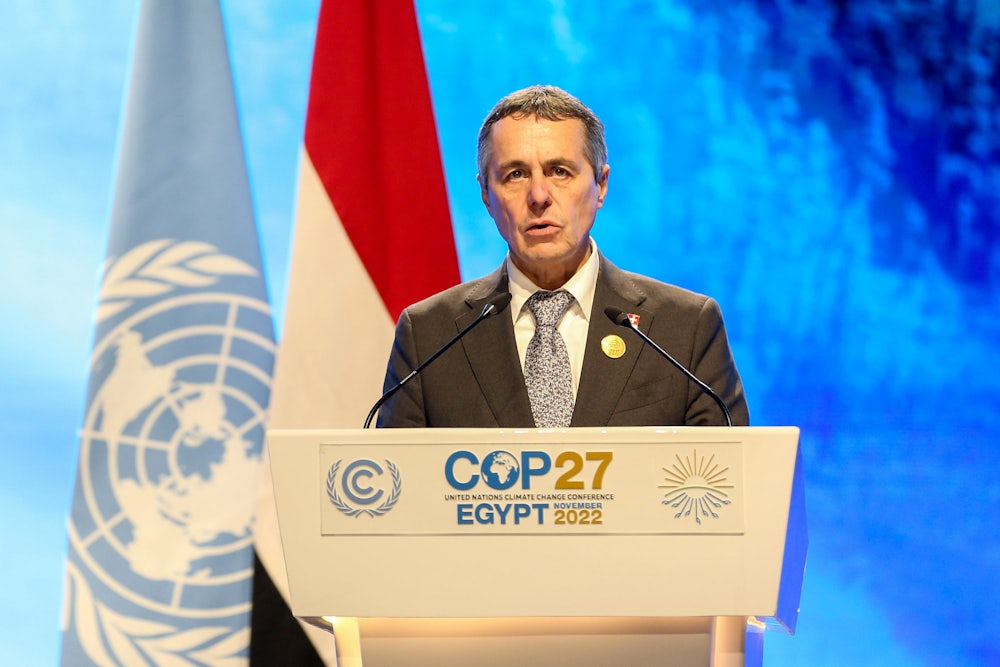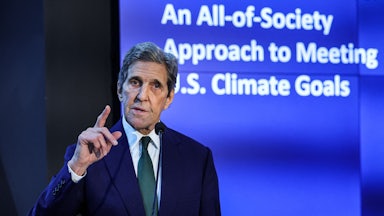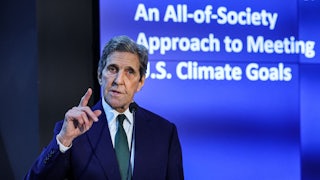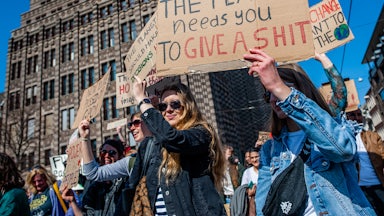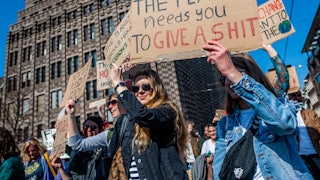In
late October, the International Energy Agency predicted for the first
time that demand for every type of fossil fuel will peak in the near future and that renewable energy investment would reach a new high by 2030. But to
avoid dangerous levels of global warming, the agency added, countries around
the world would need to do more—particularly greater investment in renewables.
“If we want to hit those more ambitious climate targets, we’d likely need to
see about $4 trillion in clean energy investment by 2030,” Fatih Birol, the IEA’s executive director, told The New York Times.
This prescription—more renewables—represents a kind of mainstream consensus on climate change. It’s a soothing message: that we can just swap out one type of energy for another without changing anything else. But while more renewables are undoubtedly needed, a growing chorus of experts warn that avoiding catastrophe won’t be possible unless wealthy countries actually reduce their energy consumption. Countries can transition away from fossil fuels much more easily, they say, if they have lower overall energy requirements; while wind and solar power are renewable, the minerals needed to make batteries to capture that energy aren’t.
“Climate experts who suggest that we’ll be able to get out of this by basically just building out renewables—that no one will be forced to use less energy or be inconvenienced in any way—are doing a grave disservice to humanity,” wrote NASA scientist Peter Kalmus on Twitter recently. “I am not talking about people voluntarily using less energy and changing their lifestyles. Far from it. Instead I am talking about the clear need for policies that begin prioritizing uses of energy and phasing out fossil fuels in a coordinated and equitable way.”
Energy reduction may seem daunting. But it’s not without precedent.
In the 1990s, researchers at the Swiss Federal Institute of Technology, or ETH Zurich, who were investigating how much energy the average person needed to live a good life came across the research of the Brazilian scientist José Goldemberg. In the 1980s, Goldemberg calculated that “by shifting to high-quality energy carriers and by exploiting cost-effective opportunities for more efficient energy use,” every person in the world could meet their basic needs—including eating, getting around, and heating their homes—“and much more” with just 1,000 watts of continuous energy; that is, approximately the amount of energy required to continuously operate an efficient vacuum cleaner.
When researchers at ETH considered how much the average person should consume in the years to come, they suggested 2,000 watts—the amount required to continuously power a hair dryer. (Some experts have argued that even 2,000 watts is too high.) At the time, 2,000 watts was the global average. In Western Europe, the average was just under 6,000 watts. In the United States, it was 12,000 watts. Switzerland had not been a 2,000-watt society since the 1960s; returning to that level would require a reduction of energy use by two-thirds.
For ETH researchers, the 2,000-watt society wasn’t just a vehicle for achieving domestic carbon reduction goals; it was also a vision of global equity on a planet with finite resources. If wealthy countries like Switzerland could decrease their energy consumption to sustainable levels, the logic went, it would give poor countries—like Bangladesh, a 500-watt society in 2004—the space to bring its energy consumption up to 2,000 watts without surpassing planetary boundaries. “There are other peoples of the planet who also have rights—the right to survive, the right to get a little bit of food every day,” Dominic Notter, a scientist formerly with the Swiss Federal Laboratories for Materials Science and Technology, explained to me by Zoom. “We limit their rights with our behavior.”
Conventional thinking holds that ever-increasing energy consumption is critical for social and economic development. Yet the 2,000-watt society concept nonetheless caught on quickly. In 2002, the Swiss Federal Council endorsed the idea. In a 2008 referendum, more than three-quarters of the Zurich population voted in favor of reducing energy consumption in the city to no more than 2,000 watts per capita while reducing greenhouse gas emissions to one ton annually per capita by 2050 without the use of nuclear energy, making it the first city in the world to give the concept democratic legitimacy.
As of 2020, according to the Swiss government, more than 100 towns and municipalities as well as 23 of the country’s 26 cantons have set the goals of the 2,000-watt society in their energy policy targets. Other cities in Europe and beyond—including Basel, Munich, Vancouver, and Canberra—have also pursued planning based on the 2,000-watt concept. “If an industrial country like Switzerland can prove that this goal is attainable, this would open new perspectives to much more populated countries,” said Marco Morosini, a former senior sustainability scientist at ETH Zurich. “This could perhaps be not one of the minor endowments of this small country to the global community.”
So-called “decoupling” of energy use from economic growth has been a longtime dream for policymakers who’d like to keep capitalism but make it greener. Some now think Switzerland is succeeding: Between 2000 and 2020, as per capita primary global energy consumption and greenhouse gas emissions both continued to rise globally, the numbers in Switzerland appear to have declined. According to the Swiss Federal Office of Energy, per capita primary energy use in the country has fallen by a third, from 6,000 watts to just under 4,000 watts, and per capita greenhouse gas emissions have dropped by almost 50 percent. While “intensified measures must be implemented in the future,” the FOE reports, the goals of the 2,000-watt society are still on track to be met between 2050 and 2100. “The direction is right, the pace is possibly a bit too slow,” an FOE representative told me.
Some Swiss climate experts and government officials, however, are not so sure. Without more substantial changes to Swiss lifestyles and politics, they say, the 2,000-watt society will remain elusive. The question now is: Are the Swiss people on board?
From the beginning, increasing energy efficiency in buildings has been a primary area of activity in Switzerland’s 2000 Watt project. It’s a commonsense target. After all, a majority of energy consumption occurs in buildings, and it’s a relatively easy place to make improvements. “In the building sector we have all we need. We have labels, we have norms, standards, products. For new buildings we are fine,” said Roland Stulz, the former director of the 2000 Watt project. Buildings also present the path of least political resistance. “In principle, nobody has anything against living in a well-insulated house. It can still be a villa for bigwigs,” said Dieter Imboden, president of the National Research Council and professor of environmental physics at ETH Zurich.
For a 2008 article on the 2,000-watt society in The New Yorker, Elizabeth Kolbert visited the Zurich headquarters of the Swiss Federal Institute of Aquatic Science and Technology, a building designed to meet the requirements of the 2,000-watt society, which uses four times less energy than a conventional building. Escorted to the premises in a Volvo that runs “on compressed natural gas produced in part from rotting vegetables,” Kolbert marveled at the building, noting its temperature-regulating exterior glass panels, its specially designed toilets, and its solar collectors.
The building supposedly proved, according to a report prepared for the 2008 World Sustainable Building Conference, that not only is the vision of a 2,000-watt society “practicable for office buildings but also that this can be achieved by using conventional materials and existing technologies.” But the report noted that creating such a building was only possible with a team of highly qualified architects, planners, and specialists and that transforming the country’s building stock would require something like an army of such individuals.
In the years since Kolbert’s visit, a mobilization does seem to have taken place. In 2011, ETH Zurich launched Novatlantis, a program tasked with executing projects—including the expansion of a municipal hospital and the redevelopment of a nursing home—that would demonstrate the “real-life feasibility of 2,000-watt society concepts and technologies.” The Swiss Federal Office of Energy, meanwhile, developed a 2,000-watt site certification for large developments, and in 2012, Zurich’s Greencity district—“a model and example for the city of the future”—became the first to be certified. Since then, 44 other developments—largely new constructions—have been certified across the country.
In Zurich, Switzerland’s largest city, the government introduced several initiatives designed to improve energy efficiency in existing homes and buildings. Over the years, thousands of contractors and planning teams have made use of the city’s “energy coaching” program, which connects them with specialists who provide low-cost advice on “all issues involved with the energy optimisation of buildings.” A similar environmental consultation program was designed specifically for small and medium-size businesses. Zurich’s city-owned power company, meanwhile, started letting customers borrow measuring devices to detect “electricity guzzlers” in their homes.
This flurry of activity tells a compelling narrative about a country of “trailblazers,” showing the world a 2,000-watt future can “look very bright,” as CBS put it in 2008. But is it enough to explain the reported dip in Switzerland’s per capita energy consumption? Not exactly, according to Tom Blindebacher, who has led Switzerland’s 2000 Watt program for the past 12 years. The numbers, he said, don’t tell the full story of the change—or lack thereof—in Switzerland in the last 20 years.
Switzerland’s reduction in primary energy consumption, Blindebacher told me, is due in part to changes in the Swiss population, which has grown by more than one million since 2000. Since a greater number of people are living in roughly the same number of buildings and using existing infrastructure, energy use appears to drop. Another explanation is the exodus of industry from the country. Since the so-called “gray energy” used to manufacture imported goods doesn’t count toward Switzerland’s energy balance sheet, energy consumption appears to drop as more goods are imported. (With gray energy included, Switzerland’s energy consumption was more than 10,000 watts per person in 2011.) A similar illusion occurs when people buy gasoline abroad. “When energy prices in Switzerland are higher than in Germany, people start to fill up their tanks in Germany. Then it seems like we in Switzerland have reduced our energy consumption. There were years where that happened. But we didn’t drive less with our cars,” Blindebacher said.
Then there’s the changing energy mix. While most of the energy—some 60 to 67 percent—put into the process of burning fossil fuels in a thermal power plant is lost, this doesn’t happen with renewables. So as Switzerland has phased out fossil fuels and increased the share of renewables to around 30 percent, demand for energy has declined. But according to Blindebacher, it doesn’t mean that energy use is markedly less. In fact, according to the Swiss Federal Office of Statistics, final energy consumption—that is, the amount of energy people actually consume—has remained relatively static. In 2000, it was 847,350 terajoules; in 2019 (before Covid-19 wreaked havoc on statistics), it was 836,230 terajoules. “Do I think that Swiss people live more efficiently than 10 years ago? No, I don’t think so,” Blindebacher said.
Energy efficiency was never meant to be the sole driver of Switzerland’s 2,000-watt transformation. “It will not happen without lifestyle change,” Rahel Gessler of Zurich’s Office for Environmental and Health Protection said bluntly in 2011.
What kind of lifestyle change, exactly? While the 2,000-watt society is precise in its goal, Swiss officials tend to shy away from recommendations in hard numbers. But the broad strokes are easy to find. A document on the Swiss Federal Office of Energy’s website, for instance, offers several “principles of action” for achieving a 2,000-watt society, such as “Skip flights,” and “Keep distances short and, if possible, cover them on foot, by bike or by public transport.” A document from the city of Zurich, meanwhile, recommends adopting a diet that consists “predominantly of plant-based products” and buying fewer new consumer goods by sharing and repairing as much as possible.
Some Swiss people have surely gotten this message and are attempting to live more energy-moderate lifestyles. In Zurich, for instance, a group led by the anarchist utopian author Hans Widmer is planning to form a 500-person cooperative, Nena1, where residents would live in 1,000-watt-compatible housing with a “personal upper limit of 2000 watts.” But bringing such lifestyles beyond a small niche requires policy change, said Troy Vettese, an environmental historian at the European University Institute and co-author of the book Half-Earth Socialism. Riding a bike instead of driving a car, for instance, “is easier to do if there are lots of bike lanes and you don’t feel like you’re going to die.”
But 2,000-watt policies can’t just focus on facilitating energy-moderate behavior, according to Morosini; they must also discourage or even eliminate energy-intensive behavior. “A flexible energy fee could be conceived: lower prices for basic energy consumption and progressive higher prices for conspicuous energy consumption,” Morosini wrote in a 2008 paper presented at the conference Ethics and Climate Change: Scenarios for Justice and Sustainability. “Taxing consumption instead of incomes, first proposed by Thomas Hobbes three centuries ago and a recurrent theme in economics, could be applied to energy policy.”
Swiss policymakers have several times attempted to advance systemic changes toward energy reduction. Traffic planners in Zurich have, as a 2011 New York Times report put it, “been working overtime in recent years to torment drivers” and reclaim public space for pedestrians. A revision to the country’s national climate law that would have increased taxes on flying and driving narrowly failed in 2021 after the oil and auto lobbies mobilized against it. A proposal to end factory farming, meanwhile, failed at the polls in September. But generally, Morosini argues, such social reforms are “rarely considered as options, debates on them are frowned upon, and, instead, vast resources are still invested to convince people to boost their consumption.”
Reducing people’s habitual energy consumption is mostly framed as a personal choice, not a matter of government intervention. In Zurich, for instance, the city offers a 2,000-watt calculator, which allows residents to figure out their energy consumption so they can adjust it accordingly on their own. The city government, meanwhile, has framed its role in bringing about a 2,000-watt society as a “role model” that can provide “attractive examples” of a 2,000-watt lifestyle. The city, however, has often shown considerable restraint in using its bully pulpit. In 2011, for instance, it began offering a “Menu Plus”—a menu composed mostly of seasonal, regional, and vegan products designed to have “60 percent less impact on the climate”—in four of its staff cafeterias. But the city stopped short of suggesting that this less energy-intensive way of eating should be required or incentivized. “We don’t want to tell people what to eat,” said Beat von Felten, a project manager with the city.
This rhetorical passivity, according to Christian Schaffner, the executive director of the Energy Science Center of ETH Zurich, is a reaction to a perceived reality: Swiss people don’t actually want to use less energy. “If you ask people in general, ‘Do you want to save the climate?’ they will say yes. If you ask them, ‘Are you OK if we forbid you to drive your private car into the city?’ they will say no,” he told me. Even in a country where a reduction of energy consumption has been approved by voters in several cities, several Swiss officials claim that so-called energy sufficiency, i.e., a reduction to sustainable levels through behavior change, is just too politically perilous to propose. “If you talk about sufficiency, you don’t get elected. So nobody talks about sufficiency,” Blindebacher said.
Even with the war in Ukraine disrupting fossil fuel supply chains in Europe, lifestyle changes to reduce energy consumption remain a tough sell. A new Federal Office of Energy campaign calls on the Swiss population to “reduce energy consumption in everyday life without sacrificing quality of life,” in light of energy shortages resulting from the war. But such campaigns fail to convince even people like Daniel Kellenberger, who until recently headed up the 2,000-watt site certification program and, when reached for an interview, was on a road trip through the United States. “People are not prepared to change their behavior, I can see that by myself. I mean, I still like to travel, I love to see other countries,” he said. “I can use my bike, I can take public transport, I can buy an electric car, I can heat my house with renewable electricity. But the last part, just not eating meat anymore and not flying everywhere. That’s going to be the tough one.”
This resistance isn’t just a matter of personal preference or Swiss culture. Energy reduction also conflicts with something much more pervasive and powerful: a capitalist society’s imperative for limitless growth. According to Toni W. Püntener, Zurich’s former deputy head of the Energy and Sustainability Department, “this focus on growth is probably the biggest stumbling block” to achieving a 2,000-watt society.
While Blindebacher agrees that “capitalism, or this whole idea of growth, doesn’t do us a lot of good,” he still thinks progress is possible: “There’s a lot to do before changing the system,” he said, noting further improvements yet to be made in renewable energy and efficiency.
Those measures, though, may not be enough to make Switzerland a 2,000-watt society. Barring significant sufficiency measures in the near future, according to Swiss energy experts, Switzerland is likely to see energy consumption plateau at unsustainably high levels. According to a 2016 report on Zurich’s 2,000-watt progress, “many of the most effective measures have already been implemented or are planned”; the city will have a per capita energy consumption of 3,500 watts by the middle of the century. The authors of a 2011 study, meanwhile, noted that the canton of Basel-Stadt could only achieve a 2,000-watt society by 2075 if “all economically, socially, and ecologically viable technical options for increasing energy efficiency and introducing renewable energy are exhausted”—not the most likely scenario. According to a 2007 analysis by Thorsten Frank Schulz, then a doctoral candidate at ETH Zurich, “using the technologies at hand by the middle of the century, we could lower the primary-energy consumption to 3500 Watts per capita … at maximum.”
Perhaps the gloomiest signal yet has been a string of bilateral agreements the Swiss government has pursued in recent years with developing nations, including Peru, Ghana, and Senegal. According to these agreements, as The New York Times reported this week, Switzerland will avoid the reduction of greenhouse gas emissions within its own borders by paying poorer nations to reduce emissions in theirs.
While Switzerland is a small country—it accounts for less than 0.1 percent of global greenhouse gas emissions—the stakes are high, as others watch how its 2,000-watt experiment fares. “Should no one single industrialized country be able to live in shared prosperity without much less than 6,000 watts per capita, this would be a dangerous message for the developing countries,” argued Morosini in his 2008 paper. To Blindebacher, Switzerland, as the country that has been pursuing a 2,000-watt society the longest, still has the best chance to present an example to the world. “Someone must try,” he said. “And who if not we, as one of the richest and the smartest and the freest countries in the world?”
